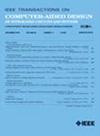Hardware Trojan Design With Low Overhead and High Destructiveness for STT-MRAM-Based CIMs
IF 2.9
3区 计算机科学
Q2 COMPUTER SCIENCE, HARDWARE & ARCHITECTURE
IEEE Transactions on Computer-Aided Design of Integrated Circuits and Systems
Pub Date : 2025-02-12
DOI:10.1109/TCAD.2025.3541483
引用次数: 0
Abstract
To overcome the von Neumann bottleneck, computing-in-memories (CIMs) have emerged as a design trend. On the other hand, with the globalization of the semiconductor supply chain, hardware Trojans have become a significant security concern. While there have been some studies on hardware Trojan designs for embedded memories in the past, there is no literature addressing hardware Trojan designs for CIMs. In this article, we propose a hardware Trojan design for spin transfer torque magnetoresistive random access memory (STT-MRAM)-based CIMs that can disrupt computing-mode operations. Our trigger circuit can evade detection during post-manufacturing memory testing, and our payload circuit can disrupt over 99% of CIM operations. Experimental results also demonstrate that compared to the original peripheral circuits of STT-MRAM-based CIMs, the area overhead and power overhead (at the TT process corner) caused by our inserted hardware Trojan are only 1.023% and 0.123%, respectively. Therefore, our hardware Trojan can easily hide within the peripheral circuits.基于stt - mram的cim低开销高破坏性硬件木马设计
为了克服冯·诺依曼瓶颈,存储器计算(CIMs)已经成为一种设计趋势。另一方面,随着半导体供应链的全球化,硬件木马已经成为一个重要的安全问题。虽然过去对嵌入式存储器的硬件木马设计有一些研究,但没有针对cim的硬件木马设计的文献。在本文中,我们提出了一种硬件木马设计,用于基于自旋转移扭矩磁阻随机存取存储器(STT-MRAM)的cim,可以破坏计算模式的操作。我们的触发电路可以在制造后的内存测试中逃避检测,我们的有效负载电路可以中断99%以上的CIM操作。实验结果还表明,与基于stt - mram的cim的原始外围电路相比,我们插入的硬件木马所造成的面积开销和功率开销(在TT工艺角)分别仅为1.023%和0.123%。因此,我们的硬件木马可以很容易地隐藏在外围电路中。
本文章由计算机程序翻译,如有差异,请以英文原文为准。
求助全文
约1分钟内获得全文
求助全文
来源期刊
CiteScore
5.60
自引率
13.80%
发文量
500
审稿时长
7 months
期刊介绍:
The purpose of this Transactions is to publish papers of interest to individuals in the area of computer-aided design of integrated circuits and systems composed of analog, digital, mixed-signal, optical, or microwave components. The aids include methods, models, algorithms, and man-machine interfaces for system-level, physical and logical design including: planning, synthesis, partitioning, modeling, simulation, layout, verification, testing, hardware-software co-design and documentation of integrated circuit and system designs of all complexities. Design tools and techniques for evaluating and designing integrated circuits and systems for metrics such as performance, power, reliability, testability, and security are a focus.

 求助内容:
求助内容: 应助结果提醒方式:
应助结果提醒方式:


